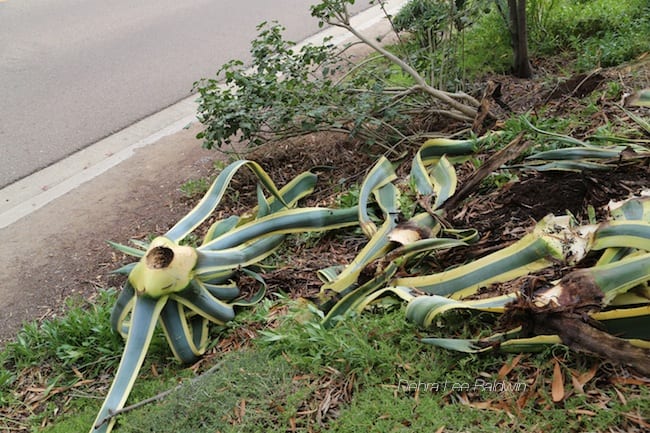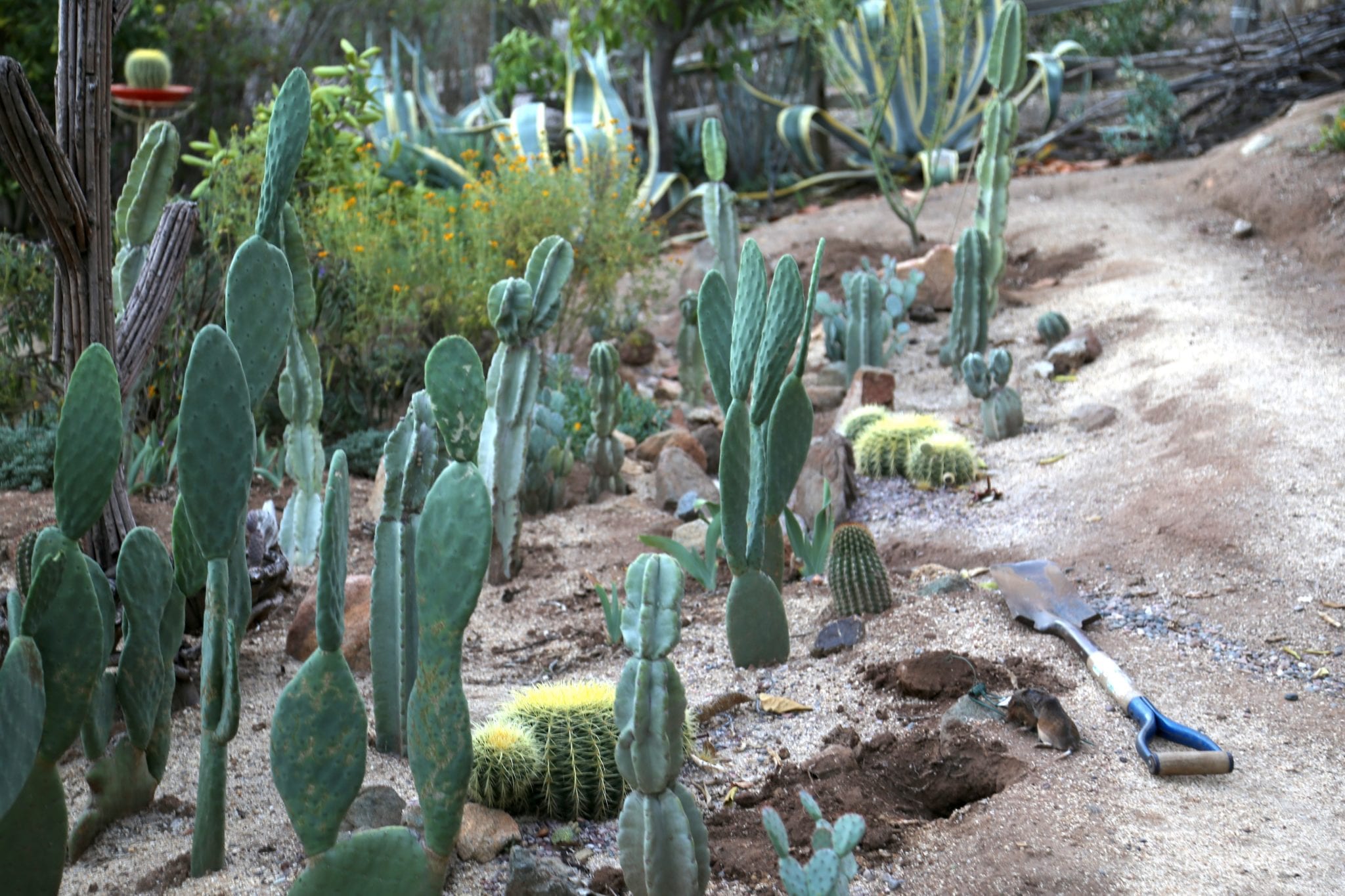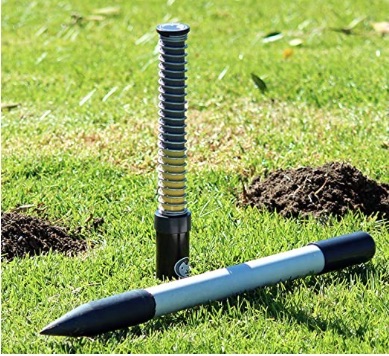
How I Get Rid of Gophers
For over a quarter of a century, I've trapped four to six gophers a year in my half-acre garden near San Diego.
Top photo: If an agave keels over and there's a clean, concave depression at its base, a gopher likely got it. But more often the cause of agave collapse is snout weevil.
UPDATE: A newly introduced gopher trap preferred by my gardener is the GopherHawk, shown here.
When I go after gophers myself, I use conventional traps like those used on the avocado ranch where I grew up.
If I can catch gophers, so can you. Here's how.

Gopher trap (photo: Sweeney's)
- Obtain at least four "Victor M9013" gopher traps (sometimes called Macabee or Sweeney's).
- Tie heavy string several feet long to the end of the trap opposite its pincher-jaws. You'll use it to pull the trap out of the hole, hopefully along with a freshly-caught gopher.
- Watch a video that shows how to set the trap.
- Pro tip: It's much easier to dig in moist soil, so after a rainstorm is a good time to set traps.
- Dig down into the tunnel with a shovel. Aim to expose two openings, one in each direction, so you can catch the gopher coming or going. (Granted, two holes aren't always possible. Gopher tunnels seldom go in a straight line, nor are they necessarily parallel to the surface.)
- With a trowel, clear each opening so there's space to insert a trap. Sometimes it's easier to reach into a hole with your hand and scoop dirt out, which also is the best way to discern if a hole does indeed lead into a tunnel.
- Insert a set trap into each hole. Hold the trap by the string end and push the metal square forward with your thumb to keep the trigger wire in place.
- Extend the string outside the hole and tie it to a stake. This ensures that you can find the trap later, that a gopher can't drag it deeper into the hole, and that you won't have to reach into the hole to remove the trap.
- Set four traps, minimum. The more tunnels you open and the more traps you set, the better your chances.
- Pro tip: Cover holes, because if a gopher sees light, it'll push dirt into the trap while trying to close the opening. I make a "roof" of cardboard. Try not to let pebbles, leaves and dirt fall into the hole.
- Check traps the next day. If they're empty, reevaluate their locations and try again.

A newly caught gopher (lower right) in my garden.
- Traps are too expensive to discard with a gopher. Shake the gopher into a plastic bag, tie the top, and set it out with the trash.
- Collapse gopher runs by slicing into them with a shovel, thereby making it less easy for a new gopher to use them. Gophers are antisocial except when mating, but if there's an unoccupied network of tunnels, one will move in.
- Pro tip: Keep open a run that leads into your yard from a neighbor's. When the opening fills with soil, you'll know a gopher is active, and you can catch it early.
Are there other options?

Above: Protect roots of vulnerable plants by lining planting holes with chicken wire.
Poison bait is another option, but it has a shelf life, may endanger pets and beneficial animals, and you don't know for sure you've caught the gopher because there's no evidence (but maybe that's a good thing). Use a metal bar to poke the ground around a gopher mound until the bar drops into a tunnel. Funnel bait through the hole into the tunnel. Cover the hole so light doesn't enter.
And no, it doesn't help to put a hose down a gopher hole. The water simply soaks into the soil.


[…] eat agave roots. Lining the planting hole with chicken wire before planting can keep gophers out. [source] http://debraleebaldwin.com/debras-garden/gophers-in-my-garden/%5D After the fact, hire a pest […]
Currently in the process of re-landscaping in the Ventura foothills. Over 24 years we were constantly doing battle with gophers. My husband was good at trapping them, and in the landscaping we did in the mid-90s we put screens down before planting. That worked, but limited re-planting.
Over the decades we started adding more succulents in one area, and my husband insists the gophers left them alone. I am thinking they were just in the one area that was not generally targeted by gophers.
About Euphorbia., I would not use. Horticulturalist Tom Ogren says to regard all euphorbia as poisonous and some even carcinogenic! I HIGHLY recommend his book “The Allergy-Fighting Garden” to anyone who is concerned (as I am) about putting more allergens into the air. Most of the book is a glossary of plants rated 1 – 10 for being allergenic. You can still have flowering plants – the issue is not how much pollen a plant produces but how MOBILE it is.
Hi Nan —
Gophers prefer the roots of edible plants, especially fruit trees, but they may go after the roots of succulents during times of drought. Screens only help a little bit—gophers do run over the top of the ground (at night). I suspect they also parachute into my garden.
You might enjoy this video in which I discuss gopher control.
P.S. I think this year I have voles. It’s always something!
Do you know if gophers will go after mangaves? I have started collecting them but hesitate to plant them out where gophers have destroyed about 30 large agaves!
Hi Connie — No idea. They haven’t found mine yet, but then the plants are in a bed surrounded by hardscape. Not that gophers couldn’t simply walk over the paving stones. Seems to me your bigger issue is getting rid of gophers regardless.